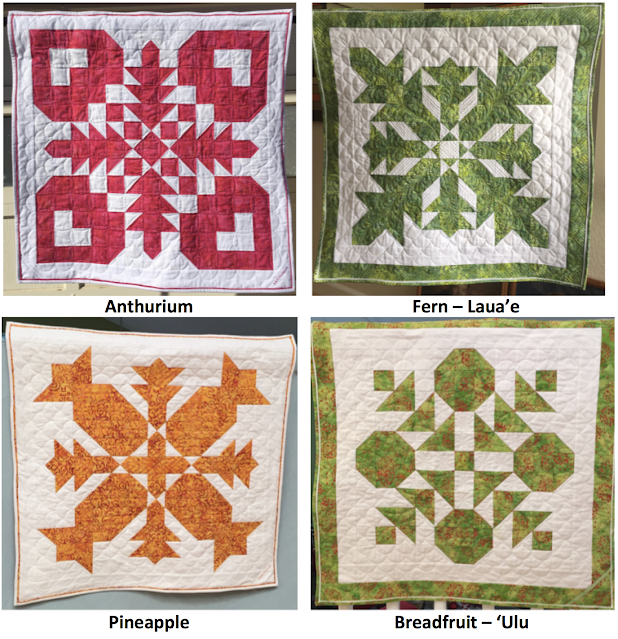This month I completed the fourth and final of my set of pieced 30" x30" Hawaiian wallhangings out of batik fabrics. It was made from a pattern from beyond the reef that has a pixellated approach to achieving a Hawaiian feel as an alternative to the otherwise rather intimidating one piece appliqué technique. After the rose-colored Anthurium, mottled-green Fern (Laua'e), and golden Pineapple, the last was the Breadfruit ('Ulu) which I chose in a bright colorway. Breadfruit was the smallest (11 squares by 11 squares) and simplest of the four, which was good because by now I was somewhat bored but determined to make a complete set. I googled pictures of the breadfruit and its their coloration and cross sections to guide me in the batik I chose for the quilt.
Aspects of the assembly were already addressed in the Anthurium (2/18/22), Fern (3/13/22) , and Pineapple (6/1/22) posts so I devoted just one photo to the row by row assembly of the Breadfruit and focused this post more on the quilting portion. There are basically four rounds and four stems composed of inverted triangles for the breadfruit. I would need to pick a design for those two features. The background I would again do in clamshells, as I had done for the previous three wall hangings.

I used an 8" arc with a 3" depth, A3; the 8" fit in well with the roughly 6" batik rounds. The 8" was wide enough, overlapping the perimeter sufficiently it did not intersect the edges at too shallow an angle. The rounds appeared more three dimensional, almost like spheres
I was on a roll with my arc templates. First I stitched diagonally down the line of inverted triangles with pairs of the smallest A5 arc, 4" wide x 1½" deep. Then I went back with the larger A4 arc, 6" wide x 2¼" deep and did the outer curves. My favorite straight edge, Slim by Angela Walters helped me travel from point to point as needed. I was pleased with the combination on the stems with the adjacent curved cross hatching on the rounds.
Like on the other three wallhangings from the beyond the reef pattern, I quilted clamshells in the outer borders. I used coral thread in the outer batik border. I used white thread in the inner border, tucking the clamshells down among the breadfruit. But this time, in the outer border, I did two rows of shells, even though suspecting that my binding would clip the tops off a second row. But I risked the clipping because I wanted the edges to be held in a bit so they would not be wavy as happened on the fern.
According to Hawaiian myth, the breadfruit tree originated from the war god Kū, who decided to live secretly among mortals and start a family. After a famine gripped their island, Kū told his wife that he could save them from starvation, but he would have to leave his family. Kū then descended into the ground where he stood, and his family watered the spot with their tears day and night until a small sapling sprouted, and quickly grew into a fully fruited breadfruit tree that saved Kū’s family and neighbors from starvation. This led to a Hawaiian saying about marriage: “look for the oozing breadfruit,” or in other words, look for the one who will always be able to feed you as Kū did for his wife and family.
- All parts of the tree, including the unripe fruit, are rich in latex, which can be used as a waterproof sealant, a paint when mixed with pigments, or in chewing gum.
- The leaves of the tree are often used as feed for livestock, fiber from the bark is traditionally fashioned into fabric for clothing, and the flowers can be burnt as a natural, powerful, insect repellant.
- The wood of the breadfruit tree is especially useful, thanks to its light weight and durability. The wood is used for everything from surfboards, traditional Hawaiian drums, and canoes, to building materials for houses, especially roofs.
- The breadfruit leaves are even believed to have medicinal properties that can alleviate asthma, cure ear and skin infections, and ease toothaches.



















Wow - a completed set! I do that regularly for clothing, but quilting? Not so much. I love the way it all came together: I think the Fern is still my favorite block, but they all look amazing. the fabric you picked for Breadfruit is spot-on, and again, I love the backing fabric! Your photo with all the different threads being auditioned tickles me pink (and makes me green with envy at your selection!) and the FMQ in the white spaces really shows the whole piece off to its best advantage. I love the way you did 2 wallhangings with borders and 2 without - it really means each block gets shown to its best advantage - and the piped bindings (and the hawaiian feel) are a pretty awesome unifying element. These projects in particular have got me lusting after quilting again, so I'm excited to see where you go next!
ReplyDeleteI love this post.
ReplyDeleteBelinda Brooke
Thank you for reading and for the compliment. I enjoyed writing it.
Delete